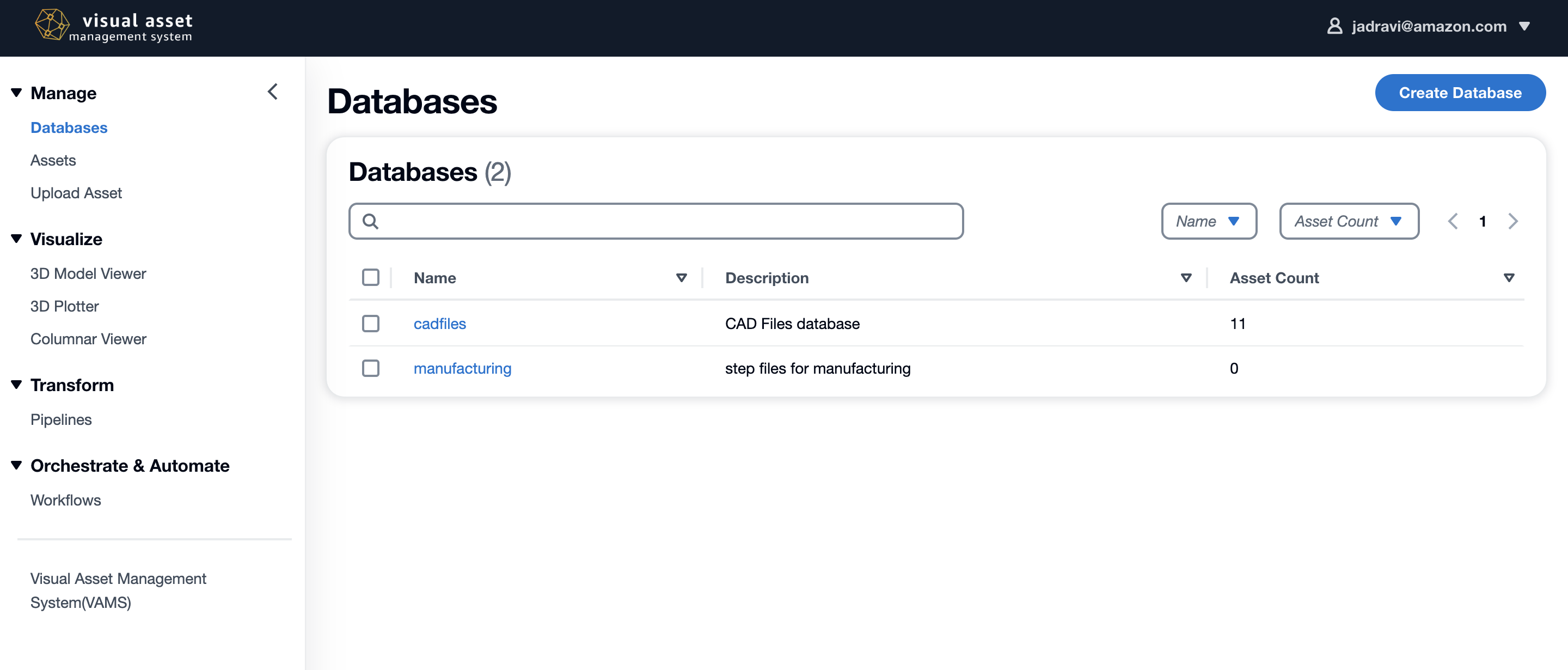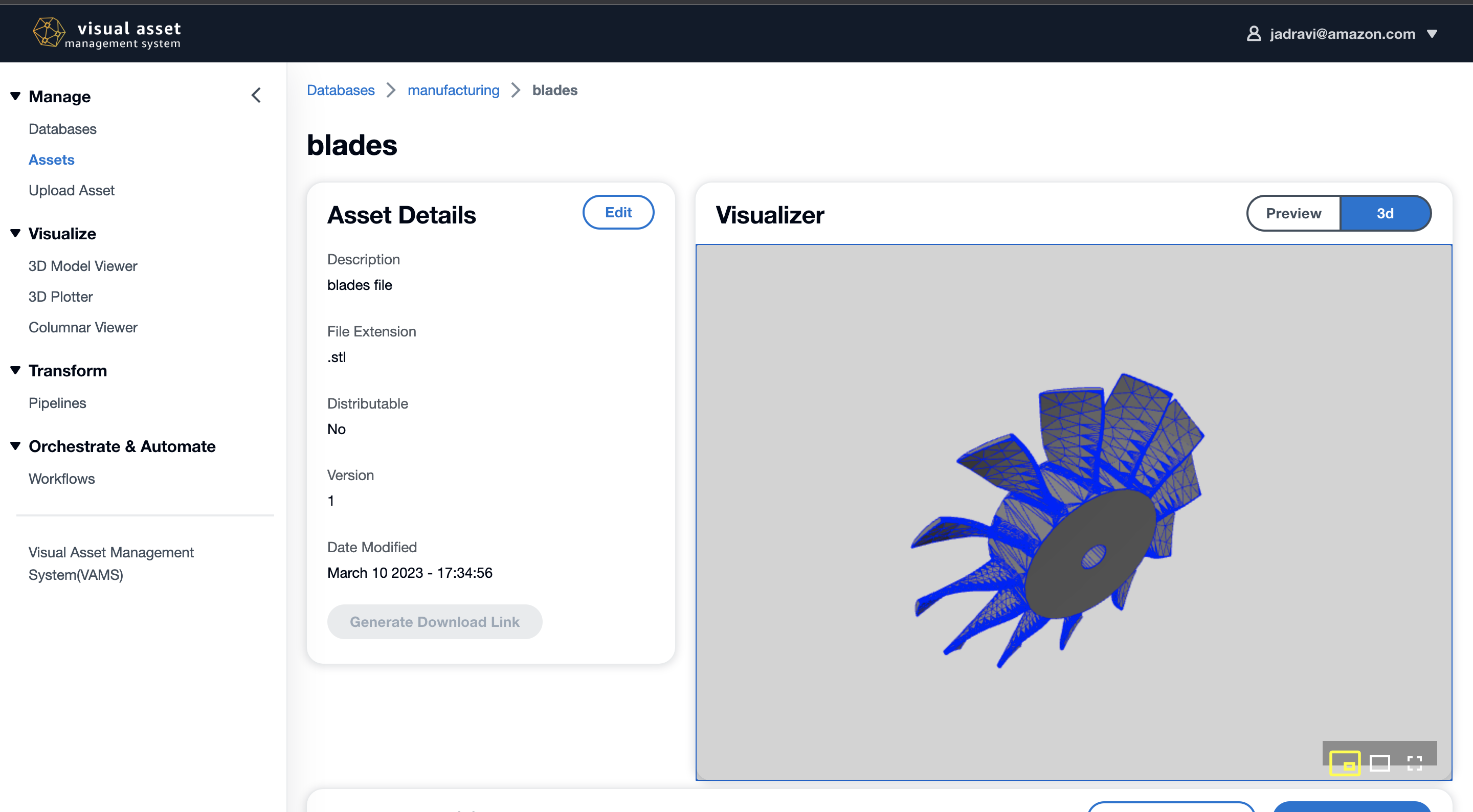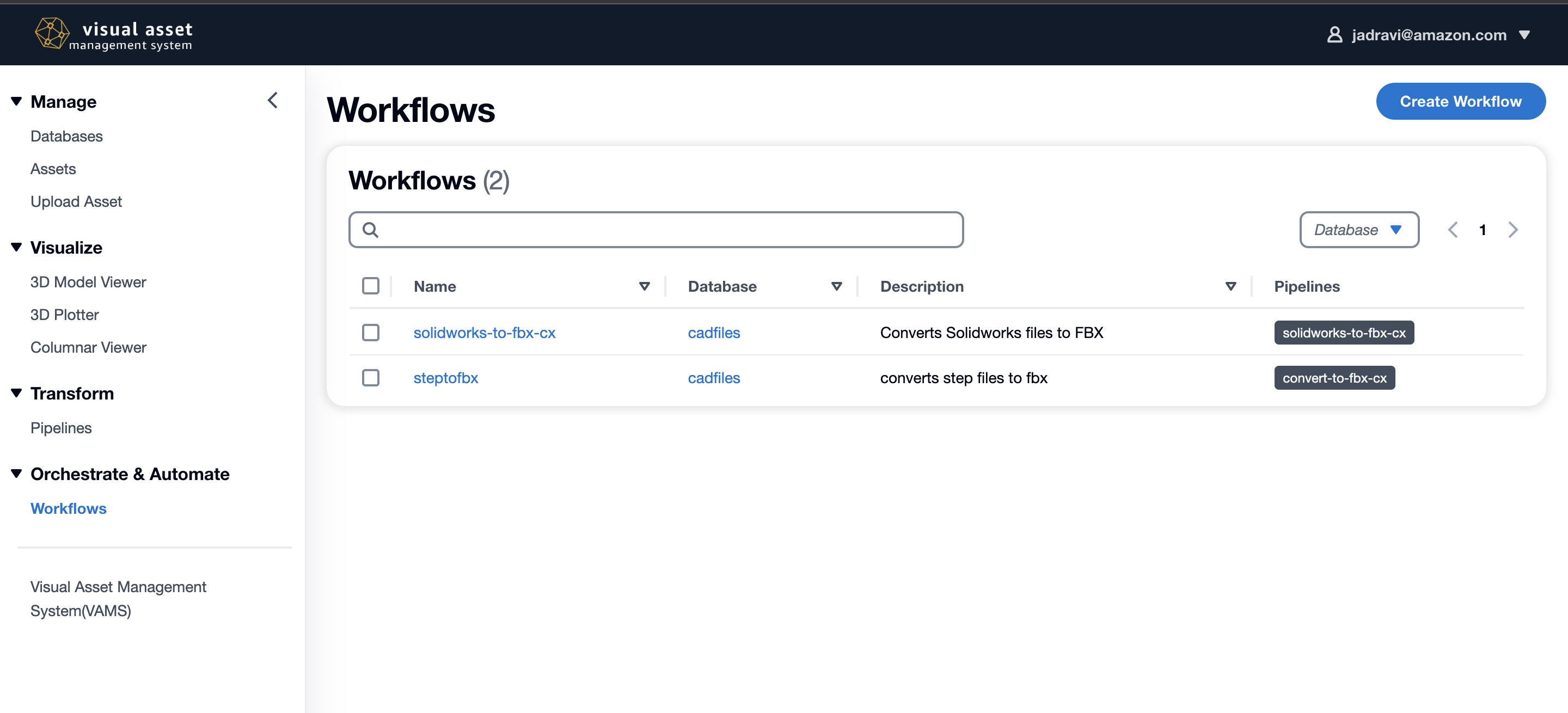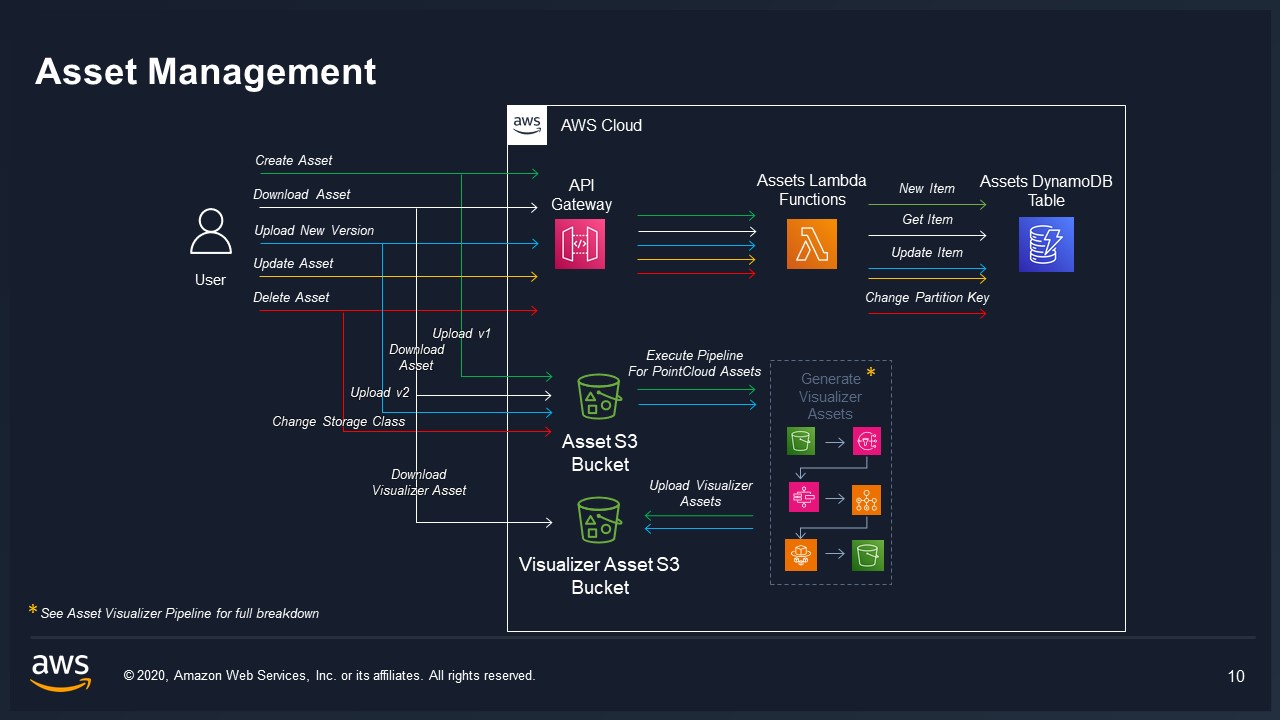Visual Asset Management System (VAMS) is a purpose-built, AWS native solution for the management and distribution of specialized visual assets used in spatial computing. VAMS offers a simplified solution for organizations to ingest, store, and manage visual assets in the cloud, which empowers any user with a web browser to upload, manage, visualize, transform, and retrieve visual assets. Existing workflows that leverage both custom code and pre-built or third-party applications can also be migrated to VAMS and ran in the AWS cloud, as opposed to being limited by the on-premise capacity available. VAMS is customizable and expandable with option of being further tailored to specific use-cases by development teams.
Customer Value: VAMS addresses challenges faced by customers embarking on Spatial Computing initiatives, such as Augmented and Virtual Reality (AR/VR). Organizations that previously had to manage these assets on local systems can now do so from a web-based application.
Leveraging Amazon Simple Storage Service (Amazon S3) as a low-cost, high availability storage layer, VAMS provides a purpose-built API for 3D asset management. This API provides a layer of abstraction, allowing custom integrations to be built. Custom integrations allow workloads and applications to be moved to the cloud, unlocking access to the entire breadth and depth of the AWS ecosystem.
Use Cases: Sample use cases that have leveraged early iterations of VAMS include:
- Distribution and management of 3D Assets using highly available S3 storage
- Modifications of 3D assets using VAMS Pipelines
- Creating workflows for 3D asset modification using VAMS Workflows
VAMS currently integrates with several different asset viewers and supports the following formats for viewing assets interactively.
| Name | Extension | Type | Viewer |
|---|---|---|---|
| Wavefront | obj | text | Online 3D Viewer |
| 3D Studio | 3ds | binary | Online 3D Viewer |
| Stereolithography | stl | text | Online 3D Viewer |
| Stereolithography | stl | binary | Online 3D Viewer |
| Polygon File Format | ply | text | Online 3D Viewer |
| Polygon File Format | ply | binary | Online 3D Viewer |
| glTF | gltf | text | Online 3D Viewer |
| glTF | glb | binary | Online 3D Viewer |
| Object File Format | off | text | Online 3D Viewer |
| Object File Format | off | binary | Online 3D Viewer |
| Dotbim | bim | text | Online 3D Viewer |
| Rhinoceros 3D | 3dm | binary | Online 3D Viewer |
| Filmbox | fbx | text | Online 3D Viewer |
| Filmbox | fbx | binary | Online 3D Viewer |
| Collada | dae | text | Online 3D Viewer |
| Virtual Reality Modeling Language | wrl | text | Online 3D Viewer |
| 3D Manufacturing Format | 3mf | text | Online 3D Viewer |
| Industry Foundation Classes | ifc | text | Online 3D Viewer |
| Point Cloud - LiDAR Data Exchange | laz | binary | Potree Viewer |
| Point Cloud - LiDAR Data Exchange | las | binary | Potree Viewer |
| Point Cloud - LiDAR Data Exchange | e57 | binary | Potree Viewer |
Viewers available include:
Please take note:
- While we are limited to these formats to view assets, any file format may be uploaded to VAMS.
- There are some limitations with formats that leverage multiple files such as glTF that uses json with references to other files.
- Some viewers like Potree Viewer requires additional pipelines to be deployed to fully generate and view visualizer files.
- Python 3.8
- Poetry (for managing python dependencies in the VAMS backend)
- Docker
- Node >=16.x
- Yarn >=1.22.19
- Node Version Manager (nvm)
- AWS CDK cli
- Programatic access to AWS account at minimum access levels outlined above.
VAMS Codebase is changing frequently and we recommend you checkout the stable released version from github.
You can identify stable releases by their tag. Fetch the tags git fetch --all --tags and then git checkout tags/TAG or git checkout -b TAG tags/TAG where TAG is the actual desired tag. A list of tags is found by running git tag --list or on the releases page.
-
cd ./web && nvm use- make sure you're node version matches the project. Make sure Docker daemon is running. -
yarn install- make sure you install the packages required by the web app (Take note,npm installdoes not result in a working build of the application - please use yarn). -
npm run build- build the web app. -
cd ../infra && npm install- installs dependencies defined in package.json. -
If you haven't already bootstrapped your aws account with CDK.
cdk bootstrap aws://101010101010/us-east-1- replace with your account and region. -
Set the CDK stack name and the region for deployment with environment variables
export AWS_REGION=us-east-1 && export STACK_NAME=dev- replace with the region you would like to deploy to and the name you want to associate with the cloudformation stack that the CDK will deploy. -
(Optional) Set the optional feature to deploy the Point Cloud (PC) visualizer pipeline with environment variables
export PIPELINEACTIVATE_PCVISUALIZER=true- the point cloud (PC) visualizer pipeline stack is for viewing Point Cloud files in the VAMS visualizer preview. You can optionally set this via CDK deploy context parameter. Note: This does deploy additional AWS components such as a VPC and EPV endpoints that may have additional static infrastructure costs. -
npm run deploy.dev adminEmailAddress=myuser@example.com- replace with your email address to deploy. An account is created in an AWS Cognito User Pool using this email address. Expect an email from no-reply@verificationemail.com with a temporary password.
-
Navigate to URL provided in
{stackName].WebAppCloudFrontDistributionDomainName{uuid}fromcdk deployoutput. -
Check email for temporary account password to log in with the email address you provided.
You can change the region and deploy a new instance of VAMS my setting the environment variables to new values (export AWS_REGION=us-east-1 && export STACK_NAME=dev) and then running npm run deploy.dev adminEmailAddress=myuser@example.com again.
To deploy customzations or updates to VAMS, you can update the stack by running cdk deploy --all. A changeset is created and deployed to your stack.
Please note, depending on what changes are in flight, VAMS may not be available to users in part or in whole during the deployment. Please read the change log carefully and test changes before exposing your users to new versions.
VAMS can be deployed with a staging-bucket parameter to enable copying from an existing asset bucket.
to deploy with staging bucket, just pass the staging-bucket paramter to your cdk deployment and VAMS will register your existing bucket as a staging bucket.
Once the deployment is complete, you can invoke the /assets/uploadAssetWorkflow API to start copying the assets into the VAMS S3 bucket.
Please refer to the uploadAssetWorkflow in the API docs to find out about the API request body.
VAMS Backend is composed of AWS Lambda functions that are accessed through an AWS API Gateway.
Pipelines are a feature in VAMS that allow you to edit
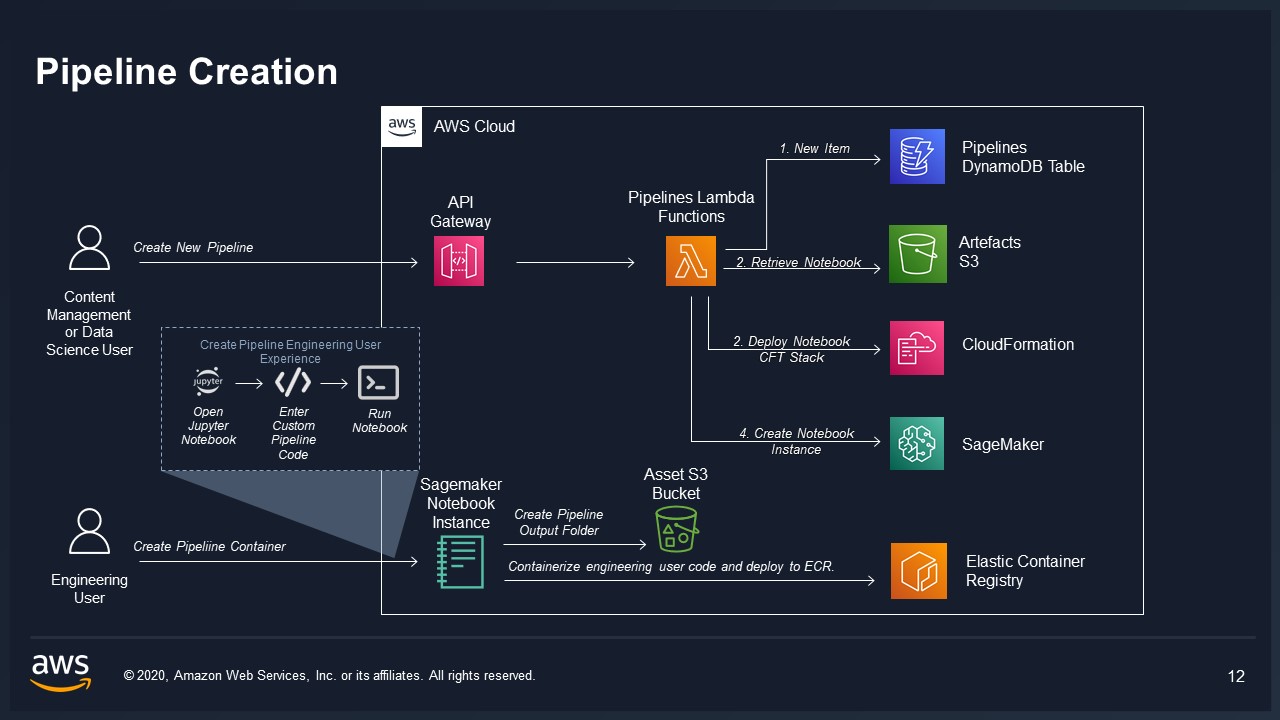
VAMS Frontend is a ReactJS application.
VAMS API and frontend are authorized through AWS Cognito user accounts by default.
Federated authentication with SAML is available with additional configuration. See SAML Authentication in the developer guide for instructions.
| component | folder |
|---|---|
| web application | web |
| cdk deployment | infra |
| api and backend | backend |
Checkout the VAMS workshop for detailed walkthrough
To know more about how VAMS works and for instructions on configuring pipeline & workflow, refer to the Developer Guide developer guide.
Refer to the Writing your own pipelines section in the Developer Guide.
VAMS is provided under a shared responsibility model. Any customization for customer use must go through an AppSec review to confirm the modifications don't introduce new vulnerabilities. Any team implementing takes on the responsibility of ensuring their implementation has gone through a proper security review.
- Run
yarn auditin thewebdirectory prior to deploying front-end to ensure all packages are up-to-date. Runyarn audit fixto mitigate critical security vulnerabilities. - When deploying to a customer account, create an IAM Role for deployment that limits access to the least privilege necessary based on the customers internal security policies.
- Run
cdk destroy --allfrom infra folder. - Some resources may not be deleted by CDK (e.g S3 buckets and DynamoDB tables, pipeline stacks). You may delete them using the AWS CLI or the AWS Console.
See the CONTRIBUTING file for how to contribute.
The costs of this solution can be understood as fixed storage costs and variable costs of the pipelines that you configure. Storage cost is proportional to the amount of data you upload to VAMS including new data you create using VAMS pipelines.
You are responsible for the cost of the AWS services used while running this solution. Ensure that you have billing alarms set within the constraints of your budget.
An approximate cost breakdown is below (excluding free tiers):
| Service | Quantity | Cost |
|---|---|---|
| Amazon API Gateway | 150000 requests | $0.16 |
| Amazon DynamoDB | 750000 writes, 146250 reads, 0.30 GB storage | $1.18 |
| AWS Lambda | 12000 invocations, 2-minute avg. duration, 256 MB memory | $6 |
| AWS Step Functions | 92400 state transitions | $2.21 |
| Amazon S3 | 10 GB storage, 4000 PUT requests, 4000 GET requests | $0.26 |
| Amazon Rekognition | 9000 Image analysis, 3 Custom Label inference units | $22.32 |
| Amazon SageMaker | 2 inference endpoints | $5.13 |
| Amazon Elastic Container Registry | ECR (In region)40GB | $4 |
Below are the additional costs for including visualizer pipeline and their outputs in your deployment:
| Service | Quantity | Cost |
|---|---|---|
| VPC | 7 VPC endpoints per AZ (1 AZ configuration){Static Cost} | $51.11 |
| Batch Fargate | 10 hours of processing | $3.56 |
| Amazon S3 | 300 GB storage, 30GB transfer out | $9.60 |
| Amazon Cloudwatch | 1GB logs - VPC Flowlogs/API Gateway/Pipeline | $3.28 |
See the LICENSE file for our project's licensing.
Copyright Amazon.com, Inc. or its affiliates. All Rights Reserved.
Unless required by applicable law or agreed to in writing, software distributed under the License is distributed on an "AS IS" BASIS, WITHOUT WARRANTIES OR CONDITIONS OF ANY KIND, either express or implied.


